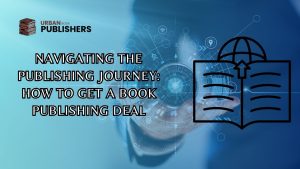
Publishing
In the modern era, aspiring authors have various avenues to publish their books, including traditional and self-publishing. However, many authors often wonder about book publishing costs through a traditional route. In this article, we will explore the cost considerations involved in publishing a book with a publisher, shedding light on the different factors that influence the expenses authors may incur. Additionally, we will briefly give you information about self-publishing costs, providing authors with a comprehensive understanding of the financial implications of their choices.
Factors Influencing the book publishing cost with a Traditional Publishing
book publishing cost with a traditional publisher entails several expenses contributing to the overall cost. Let’s examine the key factors that influence these costs.
1. The Cost of Manufacturing
The book publishing cost is determined by your choice of cover material, page count and binding style. Understand the impact of these choices on cost. Here are some factors you may want to consider when determining the manufacturing cost for your book:
1.1 Cover Material:
The material used for your book’s cover significantly impacts its manufacturing cost, as it can determine how durable your book will be over time. Hardcover books often have better durability than paperback books because they are made from thicker material. However, this doesn’t mean that paperback books aren’t durable enough for everyday use — they’re just not designed for long-term wear and tear like hardcovers are.
1.2 Page Count:
Another factor that influences manufacturing costs is page count. Books with fewer pages tend to be less expensive to print than those with more pages because the printer doesn’t need to buy as many sheets of paper at once. The number of pages also affects the thickness of each sheet, which impacts how much ink and glue is needed to bind them together into one volume.
2. The Cost of Marketing
Marketing is promoting your book and getting people to buy it. There are many ways to do this, which can cost you much money over time. Before committing to traditional publishing, you must consider how much money you want to spend on marketing. book publishers new York can help you in promoting your book through a different channel
3. The book publishing cost of Editorial Services
In addition to paying for the actual printing costs of your book and its distribution, you’ll also have to pay for editorial services. You must find an editor who is experienced in working with authors like you. Learn about the importance of finding the right editor and has an excellent track record for developing successful books. This can be one of the most important factors in determining how well your book sells once it hits store shelves!
4. The Cost of Distribution
Distribution refers to getting books into stores so that people can buy them. The distribution cost varies by publisher and store. Discover how distribution affects overall publishing costs. because it depends on how many books are shipped, where they’re shipped and how quickly they’re shipped.
Costs may also vary depending on whether you’re selling direct or through distributors and wholesalers (also known as middlemen). Many publishers have distribution networks to get books into stores; others use third-party distributors like Ingram (which supplies many independent bookstores) or Baker & Taylor (which supplies big box stores).
5. The Cost of Promotion
Authors often overlook the cost of promotion. The reality is that no matter how good your book is, you will struggle if you don’t give it the exposure it needs to do well. Some authors consider promotion optional or something they can do after publishing their book, but this is a mistake. Promoting your book from the beginning will increase its chances of success. Understand the role of early promotion in publishing and will save you money in the long run. Being an author isn’t just about writing a book; it’s about marketing and selling it too!
6. The Payout to Authors
The payout to authors is a percentage of the net revenue earned by the book. Learn more about author royalties and revenue This can vary widely depending on the publisher, but it’s typically between 15% and 25%. Some publishers will pay royalties on a sliding scale, with higher royalty rates for books that sell well.
One thing to keep in mind is that many publishers require an advance against royalties before they’ll publish your book. You must pay them back before you see any money from sales. The advance amount varies widely and depends on the perceived market demand for your book and your credentials as an author. An advance may range from $5,000 to $50,000 or more, depending on how much risk is involved in publishing your work and how much competition is from similar titles.
7. Self-book publishing cost
The Self-book publishing cost can range from free to several thousand dollars, depending on the type of publication you want. Explore the costs involved in self-publishing. depending on the type of publication you want.
Several factors influence the cost of publishing with a traditional publisher, including:
- The size of your book (word count). The more pages you have, the more it will cost.
- Your genre (fiction or nonfiction). Fiction novels are longer than nonfiction books and, therefore, more expensive.
- Your platform (social media presence). If people already know who you are, selling your book is easier because they’re already invested in your work. If not, it could take longer for people to discover your work and become interested in buying it.
8. Traditional Publishing vs. Self-Publishing
Before diving into the cost breakdown, it’s important to briefly differentiate traditional publishing from self-publishing. Traditional publishing involves submitting your manuscript to publishing houses. Understand the traditional publishing process, which evaluate it based on its market potential, quality, and fit with their publishing program. If accepted, the publisher handles the editing, design, printing, distribution, and marketing while providing the author with an advance and royalties. Self-publishing involves authors taking full control of the publishing process, from editing to marketing, with the possibility of higher profit margins.
Core Components Explored
| Aspect | Traditional Publishing | Self-Publishing |
|---|---|---|
| Manufacturing Costs | – Cover material (hardcover vs. paperback) impacts durability and cost. – Page count influences printing expenses. |
– Costs vary based on chosen materials and page count. – Greater control over cost components. |
| Marketing | – Requires a significant budget for promotion through various channels. | – Authors are responsible for their marketing strategies and expenses. |
| Editorial Services | – Costs for professional editing and developmental support. | – Authors can choose editors, balancing cost and quality. |
| Distribution | – Depends on the publisher’s network; includes shipping to stores and third-party distributors. | – Direct or third-party distribution choices with varying costs. |
| Promotion | – Essential for book success; often overlooked. Costs for publicity and exposure. | – Authors must proactively promote their work; cost-effective methods are crucial. |
| Author Payouts | – Royalties typically between 15-25% of net revenue; advance payments may be involved. | – Higher potential profit margins, but initial costs are borne by the author. |
| Considerations | – Offers a complete package but with higher costs and less creative control. | – More control and potentially higher profits, but requires more effort and investment from the author. |
Conclusion
Bringing out a book with a traditional publisher or doing it yourself comes with prices and things to consider. The costs of traditional publishing include editing, designing the book, printing, marketing, and profits. When you self-publish, you must pay for editing, cover design, writing, printing, marketing, and more, but you can make more money. To make a good decision, authors should carefully think about their goals, budget, and desired amount of involvement. Consider these factors when choosing a publishing route. No matter the publishing route, success depends on passion, persistence, and a well-written book.




